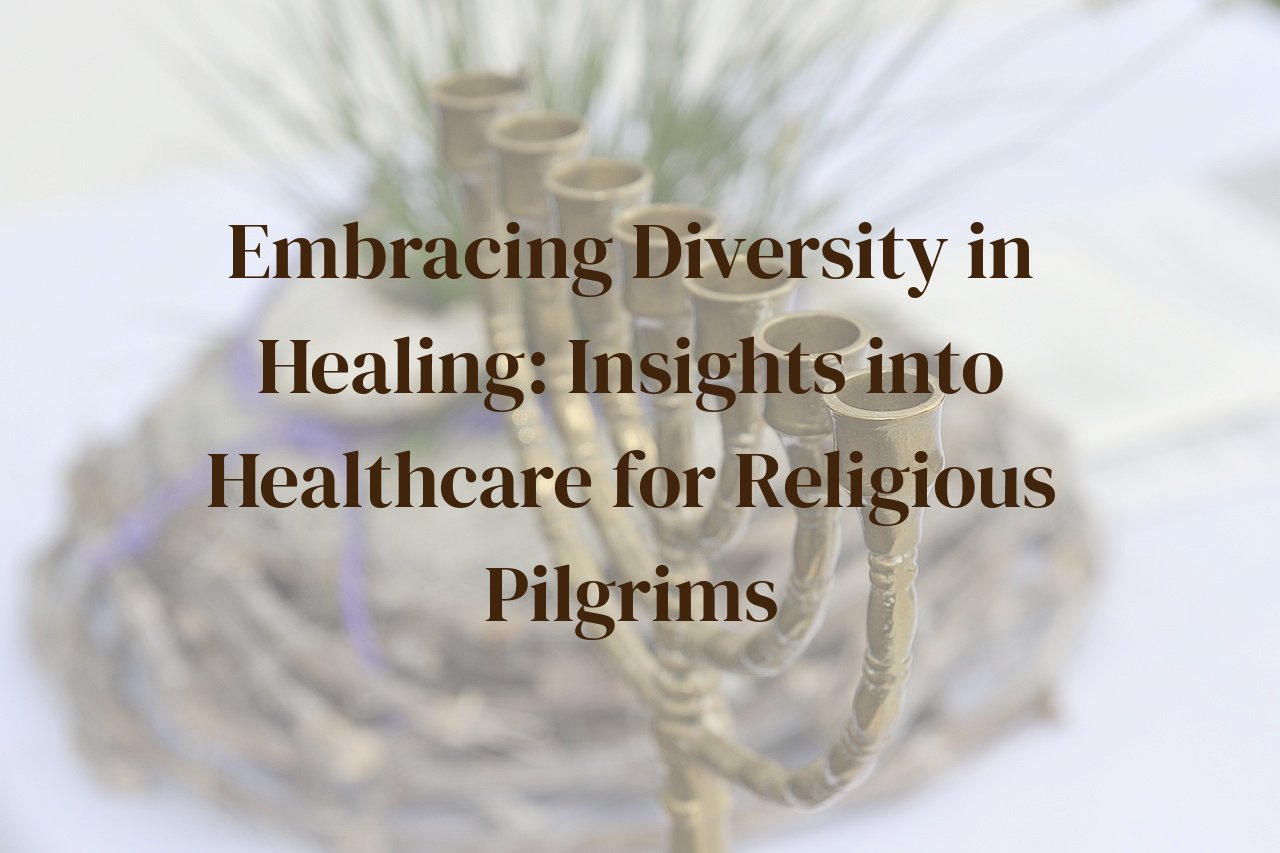
In a world rich with cultural and religious diversity, healthcare professionals are often called upon to provide medical treatment to religious pilgrims—individuals undertaking journeys of faith that transcend borders and beliefs. This blog post aims to navigate the nuanced perspectives required for culturally responsive caregiving in this unique context. Not only will we delve into the significance of cultural competencies in medical treatment, but we’ll also explore how these skills can enhance patient care and outcomes. Readers will gain a deeper understanding of the importance of respecting religious practices in healthcare settings and learn strategies for effectively engaging with patients from varied spiritual backgrounds—a toolkit essential for fostering a healing environment grounded in empathy and understanding.
Table of Contents
Understanding Pilgrim Health Needs: More Than Just Medicine
Embarking on a religious pilgrimage can be transformative for the soul, but it is often a rigorous journey for the body. In serving the unique cohort of religious pilgrims, healthcare providers must extend their understanding beyond the purview of conventional medicine. As someone who has witnessed the devotion in the eyes of pilgrims and tenderness in their stories, I’ve come to realize that treating these individuals requires tapping into their emotional, spiritual, and cultural fibres, which are inextricably linked to their well-being.
One such aspect is the impact of rigorous rituals and fasting on physical health. Pilgrims may be prone to dehydration, fatigue, or nutritional deficiencies as they adhere to strict religious precepts. Providing medical advice that respects these rituals while ensuring health can be challenging. Consequently, it is essential to offer tailored dietary recommendations and hydration strategies that align with their spiritual commitments.
Mental health, too, is paramount. The psychological stress of a pilgrimage, particularly in vast congregations, can be immense. It is critical to anticipate and recognize symptoms of anxiety, crowd-induced stress, or emotional exhaustion. In my experience, establishing mental health support through culturally-sensitive counseling or therapeutic listening booths has proven beneficial for pilgrims who may find themselves overwhelmed.
Pilgrims often travel from various corners of the globe, carrying with them not just their beliefs but also their susceptibilities to local illnesses or chronic conditions. A comprehensive understanding of endemic diseases in pilgrim-origin countries, proactive vaccination, or preventive medicine becomes part of the healthcare mosaic necessary to protect these travelers. Additionally, cater to common pilgrimage-related ailments such as blisters, muscle strains, or respiratory issues caused by dust and large gatherings.
For healthcare providers, recognizing the interplay of faith and medical compliance is pivotal. For some pilgrims, the conviction in divine protection might surpass the trust in medicine, leading to refusal or reluctance towards certain treatments or interventions. Sensitively navigating this interplay often involves working alongside religious leaders or designing interventions that do not disrupt the pilgrim’s spiritual sanctity.
In essence, when health professionals are attuned to the comprehensive needs of pilgrims, embodying not just medical acumen but also cultural sensitivity and spiritual empathy, they truly honor the diverse tapestry of health and healing. Through my own journey in supporting these devout travelers, I’ve learned that sometimes the best medicine isn’t found in a syringe or a pill but in the compassion and understanding we offer as they walk their sacred paths.
Creating Spaces of Trust: Religion and Patient Rapport
In my years as a healthcare provider, one of the most luminous paths to healing I’ve encountered involves recognizing the deep intertwining of faith and wellness in the journey of religious pilgrims. A pilgrimage is not merely a physical journey; it’s an embodiment of hope, spirituality, and the quest for meaning. Catering to the health needs of pilgrims thus requires a sacred synthesis of medical knowledge and spiritual awareness, building rapport anchored in trust and mutual respect.
Trust is the cornerstone of any therapeutic relationship, yet when it comes to treating religious pilgrims, its foundations are often laid in the fertile soil of cultural understanding. By listening with empathy to their stories, understanding their rituals, and acknowledging the sanctity of their convictions, healthcare professionals can create a sanctuary of comfort and safety for these travelers. In practice, this could be as simple as providing spaces for prayer and reflection within healthcare settings or scheduling medical appointments in a way that honors holy days and prayer times.
Deepening these connections, I recall the poignant moment when an elderly patient, weary from her pilgrimage, shared her fears with me. I found that by simply holding space for her narrative, offering a gentle presence rather than just a clinical one, we could journey through her health challenges together. Engaging, not just as a healthcare worker but as a fellow human being recognized and honored her spiritual trial.
Moreover, incorporating sacred symbols and healing words from a patient’s religious background can be profoundly comforting, and can facilitate a form of communication that surpasses words. It’s about the universal language of compassion that dissolves the barriers between different creeds, making the hospital room an extension of the pilgrimage — a place where healing is a shared mission.
Through these experiences, I’ve witnessed the alchemy of trust transform patient care. It’s a reminder that the art of healing is expansive, transcending physical remedies and embracing the diverse paths pilgrims walk. Therefore, healthcare systems must be dynamic, evolving entities that not only heal bodies but also nourish souls on their sacred voyages.
Bridging the Gap: Communication for Holistic Care
As a fervent advocate for embracing the diverse tapestry of human existence within the realm of healthcare, I’ve witnessed firsthand the transformative power that effective communication can hold within the pilgrimage journey. True healing, as I have come to understand, extends far beyond the prescriptions and treatments—it lies deeply embedded in the ability of a caregiver to forge connections that resonate with the spiritual frequencies of their patients.
In my personal encounters, the tapestry of pilgrim narratives often weaves strands of sacred rituals, language nuances, and symbolic gestures that require a keen empathic ear and a compassionate heart to decipher. Holistic care for religious pilgrims, therefore, must move fluidly like a dance, aligning with cultural rhythms and edifying the soulful dialogue between patient and provider. It’s about the subtle art of listening, hearing the unsaid prayers between words, and responding with treatments that echo the intrinsic values and beliefs of the traveller.
For the practitioner, this delicate act of bridging communication means adopting a lexicon that is both culturally attuned and respectful. It’s not merely translation services we need, but rather, intercultural conversation—a compassionate exchange that honors the very ethos guiding the pilgrim’s quest. By incorporating this into the healing process, we don’t just treat; we touch lives, we mend spirits, and we accompany our patients on a journey to wellness that transcends the physical and embraces the cosmic, uniting tapestry of faith and medicine.
The journey toward communication excellence in this context has led me to innovative strategies. Reflective listening becomes a spiritual practice, narrative medicine a prayerful reflection, and patient education a shared pilgrimage. It’s the sweet spot where science and sanctity meet, requiring of us healthcare professionals, a heart expansive enough to hold the entire universe of a patient’s experience.
Ultimately, establishing this holistic communion doesn’t only accelerate healing but also solidifies a bond of mutual respect and profound understanding. We, as healers, are not just witnesses but active participants in the sacred sojourn each pilgrim embarks upon. When we align our care with their spiritual compass, we don’t just bridge gaps—we build sanctuaries of healing that echo the divine chorus of universal kinship.
Incorporating Spiritual Practices in Medical Protocols
In my years of blogging on medicine and health, I’ve repeatedly witnessed the profound impact that incorporating spiritual practices can have in medical scenarios, especially when treating religious pilgrims. Acknowledging and respecting a patient’s spiritual rituals can play a crucial role in their healing process. For instance, offering spaces for prayer and meditation within healthcare settings can provide comfort and a sense of familiarity to pilgrims. This not only caters to their spiritual needs but also has been shown to improve clinical outcomes by reducing stress and anxiety.
Another aspect is the scheduling of medical treatments around a pilgrim’s religious activities, allowing them to maintain their spiritual commitments while receiving necessary care. When devising medical protocols, it’s essential to consider the timing of medications or procedures so they do not conflict with important religious observances. I remember a case where a patient’s chemotherapy was restructured around her prayer times, significantly enhancing her sense of control and adherence to the treatment plan.
Additionally, dietary regulations based on religious doctrines should be carefully integrated into the treatment regimens. By providing meal options that align with a pilgrim’s dietary restrictions, healthcare providers can ensure proper nutrition without compromising religious tenets. This level of detail extends to medication composition as well – ensuring prescriptions do not contain substances that go against a patient’s religious beliefs is paramount.
Education on spiritual beliefs and practices should also be a component of medical training to enhance cultural competencies amongst healthcare workers. This goes a long way in building rapport and trust, as I’ve seen patients become more open and responsive to medical interventions when their belief systems are acknowledged and incorporated into their care.
Lastly, the involvement of chaplains or spiritual care providers in the healthcare team brings an additional layer of support, offering spiritual counsel and rituals that align with the patients’ faith. They can act as vital intermediaries, ensuring that medical practices do not just heal the body, but also nurture the spirit, completing the circle of holistic care for pilgrims on their sacred journeys.
Policy and Training: Advancing Cultural Sensitivity in Healthcare Systems
Throughout my career, I’ve seen countless instances where policy shifts and dedicated training have profoundly impacted the quality of care for religious pilgrims. It’s clear that healthcare systems must embrace cultural sensitivity not as an optional accessory but as a core element of medical practice. To this end, policies need to be reevaluated and updated, reflecting the commitment to diversity and inclusivity.
First and foremost, healthcare facilities can adopt policies that mandate cultural competence training for all staff members. This isn’t a one-time seminar but an ongoing educational journey that equips medical professionals with the understanding of various religious customs and how these intersect with medical care. For instance, fasting practices during holy periods may affect treatment plans and require sensitive adjustments.
Another vital policy component is establishing frameworks that encourage patient-centered care, which respects and includes patients’ spiritual beliefs into the healing process. Hospitals can develop guidelines that facilitate quiet spaces for meditation or prayer, which, while seemingly simple, can provide immense comfort to those on a spiritual quest.
Policies must also address language barriers head-on, perhaps by ensuring that interpreter services are readily available. This extends beyond mere translation, as interpreters should be trained in religious lexicon to ensure nuanced and respectful communication.
Lastly, inclusion of cultural liaison officers within medical teams can bridge the divide between healthcare providers and the pilgrim community, ensuring that practices are not only respectful but also relevant. These officers can spearhead initiatives to update healthcare practices in real-time, based on emerging needs and feedback.
The journey towards cultural competency is ongoing and deeply nuanced. In my own blogging journey, sharing stories from these immersive trainings and policy implementations has been eye-opening. It is from this unending well of diversity that healthcare derives its true strength, constantly evolving to meet the sacred journey of every soul it serves.
Conclusion
Through the lens of personal experience and professional practice, we’ve explored the multifaceted approach necessary for treating religious pilgrims with cultural empathy and medical expertise. Recognizing the crucial intersection between cultural competence and healthcare fosters an environment where faith and healing go hand in hand. As healthcare professionals, embracing this mindset allows us to not only provide care that is respectful and effective but also to pave the way for a more inclusive and understanding medical community—ultimately enriching the sacred journey of each pilgrim we have the privilege to serve.



